
Difference Between Mechanical and Hydraulic Dock Levelers
Simply put, a dock leveler (also known as a dock plate) is a bridge that covers the gap between and building/facility and the transport vehicle, protecting both, your products and building during the loading/unloading process.
It’s important to understand the differences between these two dock plates, if chosen properly, it will be a long-term investment that will help improve the productivity of your business while also taking care of your goods.
Hydraulic Dock Leveler
Powered Dock Leveler
The hydraulic dock levelers are the easiest and most convenient to operate since they don’t require the operator to do any of the manual work, he/she will simply use the control panel to engage to the correct height and align with the trailer bed properly.

Hydraulic Dock Leveler Features
Is started by a push of a button
The push-button controls the height of the leveler and extends the lip
As the buttons are released, the platform then floats down to the trailer floor
Tends to operate in a range between 12 inches below and 12 inches above the level of the dock
Normal operations don’t require pulling a chain
When loading is complete, the operator will push a button to return the leveler to its stored position
Ergonomically efficient and easier for workers since there is no bending and chain pulling, resulting in a lower chance of injury
Hydraulic leveler consists of one motor, two cylinders, and hoses
Mechanical Dock Leveler
Manual Dock Plates
Mechanical dock levelers demand manual effort from the operator due to the mechanical parts. The operator will pull a chain to position the leveler onto the trailer and must use body weight and force to move the leveler down onto the trailer bed once it’s in the correct position and the lip is extended.
The mechanical dock leveler is your best option if you’re not planning to use it frequently during the day and if there’s low dock traffic and the loading dock supports operations but is not integral for daily tasks.

Mechanical Dock Leveler Features
Is spring-powered, requiring manual activation
Must be positioned onto a trailer first by pulling a chain which sets the “hold down” system free, letting the platform rise and the lip extend.
The operator will then walk onto the platform and use bodyweight to lower the leveler onto the trailer bed.
If the trailer is below the dock height, the operator will then pull a second chain in order to retract the support legs- this allows the platform to be positioned below the deck.
The ergonomics of a mechanical dock leveler are less efficient than a hydraulic one.
The mechanical dock leveler has springs, hold downs, lip latches, and other moving parts. These parts are consistently under pressure which causes them to have a more frequent replacement, particularly of the leveler’s springs.
Mechanical springs have heat/cold sensitivy, they expand in the heat and contract in the cold- requiring consistent adjustments.
Hydraulic cs Mechanical Dock Leveler Investment Cost
The initial investment of a hydraulic dock leveler will be more expensive. However, mechanical dock levelers usually have a higher cost of operation because of the various parts that are under tension constantly. Therefore, this will generate more repairs and higher maintenance fees, parts replacements, and downtime in the long run.
Breaking down the cost of life will help you make the best decision for your business. Consider the capital cost of the dock leveler, the approximate cost of maintenance, and the service fees. In the long run, a hydraulic dock leveler will typically have the lowest cost of living, but if you are only planning for the short-term, then a mechanical dock leveler may be a better option for you.
Still unsure which dock leveler is best suited for your business? Talk with one of our experts to help you decide which is the best option for you!
Check out our Mechanical Dock Levelers & Hydraulic Dock Levelers for more information!
